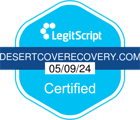Rates of Overdose Reversal Compared to Addiction Rates
The opioid epidemic that is ravaging the United States is a major threat to the overall health of Americans everywhere. The rates of overdose reversal compared to addiction rates need to change if we want to make an impact on this epidemic.
Following the loose prescription of opioids over recent years, there is now an overwhelming dependence on the class of drugs for non-medical reasons. This leads to irresponsible use and abuse of opioids once prescriptions stop being refilled. At this time, people begin to turn to the streets to satiate their addiction, leading to an entirely new danger – overdosing.
In this article, we’ll discuss the overdose-reversing drugs that have entered the market in an attempt to increase the rates of overdose reversal and help save lives.
Why Overdosing Occurs
Overdosing is when your body reacts negatively to foreign or highly concentrated substances in your body. This often occurs when something is taken in too high of a dosage. This creates a dangerous concentration of the substance in your body. Ultimately sending your system into shock in an attempt to return to homeostasis. In some cases, the body cannot recover in time. Symptoms like respiratory failure arise that eventually result in death.
When it comes to overdosing, opioids are especially dangerous. The large difference in dosing recommendations and the concentration of various opioids are a bad combination. For example, morphine is a commonly used lower-level opioid that helps to treat pain when used responsibly. However, to the average person, it looks almost identical to fentanyl – a drug that is 100 times more potent than morphine. (1) If you’re getting your opioids from anywhere but a prescription bottle at the pharmacy or hospital, there is a chance that you are actually taking a different drug that is far more potent. Taking the same dose of a different drug can – and will – kill you.
Continued after infographic:
Opioid Addiction Rates
Opioid addiction is at an all-time high, as is an opioid overdose. In just 6 years, from 2010 to 2016, the United States doubled its rate of overdose deaths from 21,089 in 2010 to 42,249 in 2016. (2) To anybody, this number is devastating. However, it can be particularly scary if you or someone you know is currently battling an addiction to opioids.
Some believe the answer is preventing the over-prescription of drugs in the future. But if you’re currently addicted, you need something to potentially save your life now. So the question becomes, what can be done to reverse opioid overdose?
There are products on the market that can reverse an opioid overdose by stopping the reaction in the body that forces you to stop breathing during an overdose. However, there is a huge difference between the prescription rates of overdose reversal drugs and new opioid prescriptions. Therefore, this isn’t helping to save lives as effectively as it could.
What Can Reverse Opioid Overdose?
One of the potentially life-saving drugs currently being used is Naloxone, which is also commonly referred to as Narcan. It is responsible for decreasing overdose deaths and increasing rates of overdose reversal (3) when used in an emergency situation. Sadly, the availability of Naloxone is not high enough to make a major difference in the fight against opioid overdose.
Currently, for every 69 prescriptions (4) of opioids administered there is only one prescription for Naloxone. Considering the number of opioid overdoses, this number needs to be significantly higher to increase rates of overdose reversal.
One way to do this is to allow wider access to the overdose reversal drug, Naloxone. A recent study shows that after CA passed a law allowing pharmacies to dispense Naloxone without a prescription, there was a 5% decrease (5) in overdose-related deaths. In addition, the AMA task force suggests increasing the number of medical professionals that participate in Prescription Drug Monitoring Programs (PDMP). This could decrease the number of opioid prescriptions.
Prescription Opioids
From 2010 to 2018, opioid prescriptions have decreased by 80 million, a 33% decrease. (6) In 2017 and 2018, the nation saw more than 20 million fewer prescriptions. By limiting access to prescription opioids, overdose reversal is possible and the vicious cycle can be slowed. This system prevents people from developing new addictions, helping to eliminate the need for such drugs in the future.
Increasing access to opioid reversal drugs such as Naloxone has proven to be successful. In 2018, the number of naloxone prescriptions reached a record high in the United States. More than 598,000 naloxone prescriptions were given – a 107% increase from 2017.
Recently, the U.S. Surgeon General, Jerome Adams, issued a public statement (7) urging those who might know someone who is at risk for opioid addiction to carry around Naloxone. (8) This non-addictive, life-saving drug can reverse an opioid overdose if administered in time. Mr. Adams recommends that family members and friends of those afflicted with opioid addiction carry one when in the presence of the individual. He also recommends that emergency personnel and bars carry Naloxone to help mitigate some of the problems.
Using Naloxone to Reverse an Overdose
There are 3 ways Naloxone (Narcan) can be administered: nasal spray, injection, or auto-injector. In the event of an emergency and suspected overdose, 911 should be called first and then Narcan administered. Sometimes multiple doses are needed, but a short wait period of 3-5 minutes should be observed before administering a second dose. In the interim, if the victim is not responding, CPR should be given. It is possible to save a life administering this non-addictive drug to an overdose victim.
If you’re wondering how you can get Naloxone, then you may be able to go to your nearest pharmacy without a prescription. 41 states, including AZ, have passed laws that allow pharmacies to distribute this life-saving drug without a prescription. This eliminates a once- prohibitory barrier to getting this drug into the hands of people who can save lives. The drug can be covered by insurance as well, potentially in generic form so be sure to ask your pharmacist.
Getting Help Before Overdose Occurs
Ultimately, if you or someone you know is struggling with opioid addiction, Naloxone can be a lifesaver in an emergency situation. However, it is better to prevent an overdose occurring than reacting to an emergency.
To save yourself from becoming an overdose statistic, consider looking into a full-time opioid recovery program that will eliminate the need to ever worry about an overdose. The dedicated team at Desert Cove Recovery is well-trained and experienced in treating opioid addictions and the underlying causes of such a disease. Co-occurring disorder treatment can help to identify the cause of your addiction. Addressing these issues so that you no longer need to cope, and lead you towards sober living and recovery.
It’s not too late – call Desert Cove Recovery today to get the help you need.
Sources:
(1) https://www.addictionsandrecovery.org/opioid-opiate-recovery.htm
(2) https://www.hhs.gov/surgeongeneral/priorities/opioids-and-addiction/naloxone-advisory/index.html
(3) https://www.drugs.com/pro/narcan.html
(4) https://www.cdc.gov/mmwr/volumes/68/wr/mm6831e1.htm
(5) https://www.courthousenews.com/california-widens-access-to-opioid-overdose-antidote/
(6) https://www.ama-assn.org/system/files/2019-06/opioid-task-force-progress-report.pdf
(7) https://www.hhs.gov/surgeongeneral/priorities/opioids-and-addiction/naloxone-advisory/index.html
(8) https://www.azcentral.com/story/news/local/phoenix/2017/05/24/attorney-general-cvs-make-anti-overdose-drug-available/339993001/




